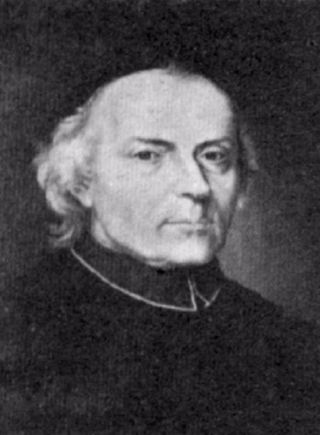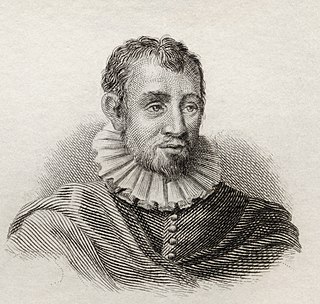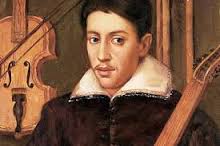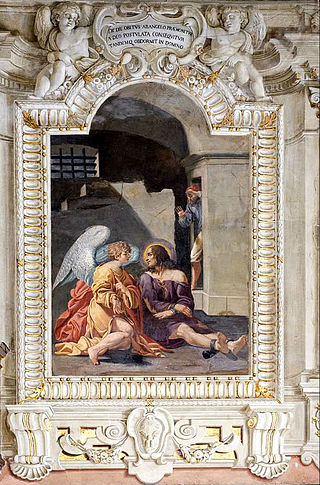Related Research Articles

Paolo Agostino was an Italian composer and organist of the early Baroque era. He was born perhaps at Vallerano, near Viterbo. He studied under Giovanni Bernardino Nanino, according to the dedication in the third and fourth books of his masses. Subsequently, he married Nanino's daughter.

Josquin Lebloitte dit des Prez was a composer of High Renaissance music, who is variously described as French or Franco-Flemish. Considered one of the greatest composers of the Renaissance, he was a central figure of the Franco-Flemish School and had a profound influence on the music of 16th-century Europe. Building on the work of his predecessors Guillaume Du Fay and Johannes Ockeghem, he developed a complex style of expressive—and often imitative—movement between independent voices (polyphony) which informs much of his work. He further emphasized the relationship between text and music, and departed from the early Renaissance tendency towards lengthy melismatic lines on a single syllable, preferring to use shorter, repeated motifs between voices. Josquin was a singer, and his compositions are mainly vocal. They include masses, motets and secular chansons.

Pachelbel's Canon is an accompanied canon by the German Baroque composer Johann Pachelbel. The canon was originally scored for three violins and basso continuo and paired with a gigue, known as Canon and Gigue for 3 violins and basso continuo. Both movements are in the key of D major. The piece is constructed as a true canon at the unison in three parts, with a fourth part as a ground bass throughout. Neither the date nor the circumstances of its composition are known, and the oldest surviving manuscript copy of the piece dates from 1838 to 1842.

Lodovico Antonio Muratori, commonly referred to in Latin as Muratorius, was an Italian Catholic priest, notable as historian and a leading scholar of his age, and for his discovery of the Muratorian fragment, the earliest known list of New Testament books.

Agostino Agazzari was an Italian composer and music theorist.
Johannes Ciconia was an important Franco-Flemish composer and music theorist of trecento music during the late Medieval era. He was born in Liège, but worked most of his adult life in Italy, particularly in the service of the papal chapels in Rome and later and most importantly at Padua Cathedral.

LodovicoZacconi was an Italian composer and musical theorist of the late Renaissance and early Baroque eras. He worked as a singer, theologian, and writer on music in northern Italy and Austria; for a time he was in the employ of Archduke Karl of Graz, and worked in Graz and Vienna.
Lodovico Grossi da Viadana was an Italian composer, teacher, and Franciscan friar of the Order of Friars Minor Observants. He was the first significant figure to make use of the newly developed technique of figured bass, one of the musical devices which was to define the end of the Renaissance and beginning of the Baroque eras in music.

Leonardo Agostini was an Italian antiquary of the 17th century, born in Boccheggiano, near Grosseto.
Lodovico Agostini was an Italian composer, singer, priest, and scholar of the late Renaissance. He was a close associate of the Ferrara Estense court, and one of the most skilled representatives of the progressive secular style which developed there at the end of the 16th century.
Anna Guarini, Contessa Trotti was an Italian virtuoso singer of the late Renaissance. She was one of the most renowned singers of the age, and was one of the four concerto di donne at the Ferrara court of the d'Este family, for whom many composers wrote in a progressive style.

Francesco Carracci was an Italian painter and engraver, and nephew of the more famous Agostino Carracci.

Claudio Achillini was an Italian philosopher, theologian, mathematician, poet, and jurist. He is a major figure in the history of Italian Baroque poetry.

The concerto delle donne was an ensemble of professional female singers of late Renaissance music in Italy. The term usually refers to the first and most influential group in Ferrara, which existed between 1580 and 1597. Renowned for their technical and artistic virtuosity, the Ferrarese group's core members were the sopranos Laura Peverara, Livia d'Arco and Anna Guarini.
Lodovico is an Italian masculine given name, and may refer to:
The decade of the 1530s in music involved some significant events, publications, compositions, births, and deaths.
Agostini is an Italian surname. Notable people with the surname include:
Hoste da Reggio was an Italian composer of the Renaissance, active in Milan and elsewhere in northern Italy. He was well known for his madrigals, which were published in several collections in Venice.
References
- ↑ Schiltz, Katelijne; Blackburn, Bonnie J. (2007). Canons and canonic techniques, 14th-16th centuries: theory, practice and reception history. p. 358.
- ↑ Sadie, Stanley; Tyrrell, John (2001). The new Grove dictionary of music and musicians: Volume 1.
- ↑ Iain Fenlon (Oct 30, 2008). Music and Patronage in Sixteenth-Century Mantua. Cambridge University Press. p. 92. ISBN 9780521088336. Archived from the original on June 2, 2019. Retrieved June 2, 2019.